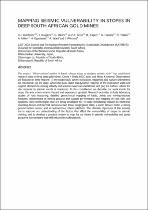JavaScript is disabled for your browser. Some features of this site may not work without it.
- ResearchSpace
- →
- Research Publications/Outputs
- →
- Conference Publications
- →
- View Item
| dc.contributor.author |
Durrheim, RJ

|
|
| dc.contributor.author |
Kuijpers, J

|
|
| dc.contributor.author |
Henry, G

|
|
| dc.contributor.author |
Brink, AVZ

|
|
| dc.contributor.author |
Kagezi, B

|
|
| dc.contributor.author |
Ferreira, G

|
|
| dc.contributor.author |
Teleka, Ruth

|
|
| dc.contributor.author |
Milev, A

|
|
| dc.contributor.author |
Ogasawara, H

|
|
| dc.contributor.author |
Ward, A

|
|
| dc.contributor.author |
Wienand, J

|
|
| dc.date.accessioned | 2014-02-13T08:57:30Z | |
| dc.date.available | 2014-02-13T08:57:30Z | |
| dc.date.issued | 2013-09 | |
| dc.identifier.citation | Durrheim, R.J, Kuijpers, J, Henry, G, Brink, A.V.Z, Kagezi, B, Ferreira, G, Teleka, R, Milev, A, Ogasawara H, Ward, A and Wienand, J. 2013. Mapping seismic vulnerability in stopes in deep South African gold mines. In: Proceedings of the Eighth International Symposium on Rockbursts and Seismicity in Mines, Saint Petersburg, Moscow, Russia, 1-7 September 2013 | en_US |
| dc.identifier.isbn | 978-5-903258-28-4 | |
| dc.identifier.uri | http://hdl.handle.net/10204/7204 | |
| dc.description | Proceedings of the Eighth International Symposium on Rockbursts and Seismicity in Mines, Saint Petersburg, Moscow, Russia, 1-7 September 2013. Abstract only attached. | en_US |
| dc.description.abstract | The project “Observational studies in South African mines to mitigate seismic risks” has established research sites in three deep gold mines, Cooke 4 Shaft, KDC West and Moab Khotsong. Observations are focused on three regions: (i) the target fault, where nucleation, triggering and rupture phenomena are monitored; (ii) the stope, where the quasi-static and dynamic response of the excavation walls and support elements to mining activity and seismic events are monitored; and (iii) the surface, where the site response to seismic events is monitored. In this contribution we describe our work inside the stope, the area where seismic hazard and exposure is greatest. Research activities include laboratory studies of rock fracturing; detailed geotechnical mapping of faults, joints and mining-induced fractures; observations of mining practice and support performance; and mapping of rock falls and ejections. New technologies that are being developed for in-stope monitoring include an electronic sounding device and thermal camera to map loose hangingwall slabs, a sonic closure meter, a strong ground motion sensor, and an autonomous robotic platform. The ultimate objectives of this activity are to improve our understanding of the factors that affect the vulnerability of stopes to seismic shaking, and to develop a practical system to map the variations in seismic vulnerability and guide proactive interventions that will reduce the rockburst risk. | en_US |
| dc.language.iso | en | en_US |
| dc.relation.ispartofseries | Workflow;11747 | |
| dc.subject | South African mines | en_US |
| dc.subject | Mining-induced seismicity | en_US |
| dc.subject | Rockbursts | en_US |
| dc.subject | Stopes | en_US |
| dc.subject | Japan - South African research | en_US |
| dc.title | Mapping seismic vulnerability in stopes in deep South African gold mines | en_US |
| dc.type | Conference Presentation | en_US |
| dc.identifier.apacitation | Durrheim, R., Kuijpers, J., Henry, G., Brink, A., Kagezi, B., Ferreira, G., ... Wienand, J. (2013). Mapping seismic vulnerability in stopes in deep South African gold mines. http://hdl.handle.net/10204/7204 | en_ZA |
| dc.identifier.chicagocitation | Durrheim, RJ, J Kuijpers, G Henry, AVZ Brink, B Kagezi, G Ferreira, R Teleka, et al. "Mapping seismic vulnerability in stopes in deep South African gold mines." (2013): http://hdl.handle.net/10204/7204 | en_ZA |
| dc.identifier.vancouvercitation | Durrheim R, Kuijpers J, Henry G, Brink A, Kagezi B, Ferreira G, et al, Mapping seismic vulnerability in stopes in deep South African gold mines; 2013. http://hdl.handle.net/10204/7204 . | en_ZA |
| dc.identifier.ris | TY - Conference Presentation AU - Durrheim, RJ AU - Kuijpers, J AU - Henry, G AU - Brink, AVZ AU - Kagezi, B AU - Ferreira, G AU - Teleka, R AU - Milev, A AU - Ogasawara, H AU - Ward, A AU - Wienand, J AB - The project “Observational studies in South African mines to mitigate seismic risks” has established research sites in three deep gold mines, Cooke 4 Shaft, KDC West and Moab Khotsong. Observations are focused on three regions: (i) the target fault, where nucleation, triggering and rupture phenomena are monitored; (ii) the stope, where the quasi-static and dynamic response of the excavation walls and support elements to mining activity and seismic events are monitored; and (iii) the surface, where the site response to seismic events is monitored. In this contribution we describe our work inside the stope, the area where seismic hazard and exposure is greatest. Research activities include laboratory studies of rock fracturing; detailed geotechnical mapping of faults, joints and mining-induced fractures; observations of mining practice and support performance; and mapping of rock falls and ejections. New technologies that are being developed for in-stope monitoring include an electronic sounding device and thermal camera to map loose hangingwall slabs, a sonic closure meter, a strong ground motion sensor, and an autonomous robotic platform. The ultimate objectives of this activity are to improve our understanding of the factors that affect the vulnerability of stopes to seismic shaking, and to develop a practical system to map the variations in seismic vulnerability and guide proactive interventions that will reduce the rockburst risk. DA - 2013-09 DB - ResearchSpace DP - CSIR KW - South African mines KW - Mining-induced seismicity KW - Rockbursts KW - Stopes KW - Japan - South African research LK - https://researchspace.csir.co.za PY - 2013 SM - 978-5-903258-28-4 T1 - Mapping seismic vulnerability in stopes in deep South African gold mines TI - Mapping seismic vulnerability in stopes in deep South African gold mines UR - http://hdl.handle.net/10204/7204 ER - | en_ZA |






